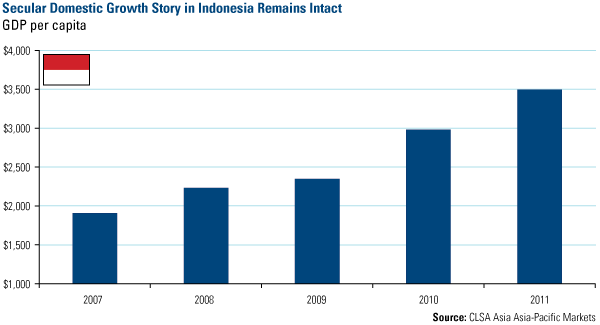Emerging Markets Radar (March 26, 2012)
Strengths
- China has cut the required reserve ratio (RRR) for 379 branches of the Agriculture Bank of China to boost rural area loan volumes, signaling fine-tuning monetary easing. The market is currently expecting further RRR cuts for all the banks this year.
- China has raised gasoline and diesel prices by 7 percent and 7.76 percent, respectively. After the increase, the downstream refinery business is closer to breakeven.
- Singapore’s Consumer Price Index (CPI) rose 4.6 percent in February, unexpectedly slowing as communication costs fell in the city state. In Malaysia, consumer prices also slowed, rising 2.2 percent year-over-year in February, down from 2.7 percent in January and well below the market estimate of 2.5 percent. The key reason for the decline in inflation was a drop in food price inflation.
- The Philippines’ budget deficit narrowed to 15.9 billion pesos ($370 million) in January from 101.5 billion pesos the previous month. In Thailand, the Bank of Thailand left its benchmark rate at 3 percent, pausing after two recent reductions. The result was widely expected.
- Nouriel Roubini turned more positive on Colombia, revising his 2012 and 2013 growth forecasts to 5 and 4.5 percent, respectively, citing a dissipation of downside risk from the global economy and a cool-down in domestic economic activity.
- The Brazilian labor market is showing that conditions are getting better for consumers. Although the February unemployment rate inched up to 5.7 percent from 5.5 percent in January and 4.7 percent in December, after stripping out seasonality, the unemployment rate remained at the series' record low of 5.6 percent for the fourth consecutive month. Employment grew 0.6 percent month-over-month (while the number of unemployed workers dropped by 0.5 percent), which coupled with the 0.7 percent increase in real wages, pushed the real wage bill up by 1.3 percent month-over-month or by 17 percent in annualized terms.
- The number of people employed in South Africa’s formal sector inched up 0.3 percent in the fourth quarter of 2011, with the manufacturing sector primarily adding the jobs. Employment rose by 23,000 people during the last quarter of 2011, to 8.381 million, and was up 1.6 percent on a year-over-year basis, Statistics South Africa said.
Weaknesses
- HSBC March China Flash Purchasing Managers’ Index (PMI) was 48.1, down 1.5 from February’s 49.6, indicating industrial activities are further contracting, particularly in export-oriented manufacturers.
- Bloomberg news reports today that CBRC said China banks misclassified RMB1.8 trillion (20 percent) of local government loans as fully-cash-flow-covered due to the inclusion of government subsidies. CICC bank analysts will check whether CBRC people have said this or not, but bank analyst Mao Junhua does not believe the 1.8 trillion number is correct.
- Lending by China’s four biggest banks was less than RMB 50 billion from March 1 to 15, the Economic Information Daily reports.
- BCA research reported recently that India’s capital rationing is deterring growth, and predicts a financial crunch in 2012, which will hamstring much-needed capital spending. The firm suspects that India’s potential growth rate is declining because of slowing productivity gains, which in turn are due to lower savings and investment rates.
Opportunities
- The South African rand gained for the first time in four days on Friday, trimming its worst weekly loss in six weeks, before data forecast to show U.S. sales of new homes rose last month, dampening demand for the dollar as a haven.
- Following a severe contraction in the fourth quarter of 2011, Thailand is in the midst of a solid rebound that should bring back a growth trend by the end of the year with a 5.3 percent annual expansion, Nouriel Roubini said this week.
- Verbal intervention from governments to bring down the price of crude has increased, in addition to rumors of an agreement between the U.S. and the U.K. to tap into strategic reserves. In fact, France has officially said that it and other industrialized nations are considering a strategic reserves release. Furthermore, Saudi Arabia has called present prices “unjustified,” citing a global supply surplus of 1-2 million barrels per day, signaling that it is prepared to increase production by 25 percent to bring prices down if needed.
- Indonesia’s stock market has lagged its peers this year, primarily due to the overhang of rising inflation risk. This is the result of the removal of government subsidies in fuel and power prices, and wage increases this year. However, the drivers of the economy in Indonesia (i.e., rising foreign direct investment, infrastructure construction, and rising middle class consumption) are intact and, therefore, the stock market appears to be a long-term play.

Threats
- The Chinese economy is still in the process of a soft landing, which may cause uncertainties for the economy.
- Poland’s shale gas reserves are about one-tenth the size of previous estimates, a government report showed this week, denting hopes for an energy source that could play a key role in weaning Europe off Russian gas. The long-awaited study estimated Poland's recoverable shale reserves at 346 to 768 billion cubic meters, far less than the previous estimate of 5.3 trillion from the U.S. Energy Information Association.
- South Africa’s foreign affairs ministry said it is reducing Iran oil imports, as its largest supplier of crude oil faces international sanctions. The industry awaits further detail, as a national oil industry group said it hadn’t been informed of the plan.












